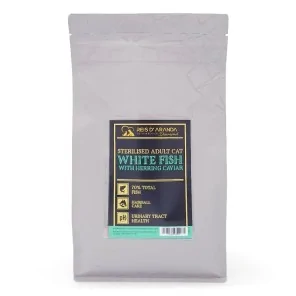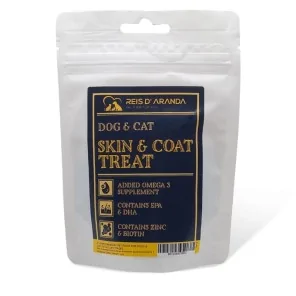The Tornjak originated from genetically homogeneous, almost extinct, indigenous shepherd dogs. These dogs have...
THE NORWEGIAN FOREST CAT
INTRODUCTION
The Norwegian Forest Cat (Norwegian: norsk skogkatt or norsk skaukaes) is a breed of cat endemic to Scandinavia. It is now popular as a domestic feline in households throughout Europe.
THE ORIGIN OF THE NORWEGIAN FOREST CAT
Its exact origin is unknown. It is believed to be the result of interbreeding between prehistoric short-haired cats from southern Europe that migrated to Scandinavia and other long-haired cats from the Middle East. But there are many other conjectures.
All indications are that Norwegian forest cats are relatively ancient, although they have only recently become popular. References to them can already be found in Norse mythology. The chariot of the goddess Freya was drawn by white cats of this breed. Legend has it that the god Thor, the strongest of all gods, was unable to lift the goddess' chariot. Other folk tales claim that the Vikings travelled with cats endemic to their area, presumably of this breed, to control rodent infestations on their boats, although the most plausible historical source is the documents of Peter Friis, a Danish priest living in Norway, who in 1599 classified the Norwegian lynx into three different types: wolf-lynx, fox-lynx and finally the lynx-cat. Today, thanks to his descriptions, it is known that the lynx-cat is none other than the Norwegian forest cat.
In 1976, the FIFe recognised the breed, using Pans Truls, the most famous Norwegian forest cat of all times, as a model. The popularity of the breed grew considerably when King Olav of Norway proclaimed it the ‘national mascot’. Subsequently, other cat associations also recognised it as a breed, and although they developed their own standards, the differences between them are not mutually exclusive.
Initially, the export of the breed was very restricted. Until 1990, feral cats were added to the catteries. The ban was a controversial measure. Proponents believe that there is no longer a danger of inbreeding, while opponents believe that some of the breed's traits may be lost.
WHAT IS THE NORWEGIAN FOREST CAT LIKE?
GENERAL: Large sized cat.
HEAD: Triangular in shape with all sides equal. When viewed in profile, the head is of good height. Forehead slightly rounded. Profile long and straight with no break in its line (no stop). Firm chin.
EARS: Large and broad at the base. Plumes of lynx tufts at the tips and tufts of hair emerging from the ears are desirable. Set on high and open, so that the outer line of the ears follows the line of the head to the chin.
EYES: Large, almond-shaped, wide open, slightly slanting. Alert expression. All colours are permitted, irrespective of coat colour.
BODY: long, stocky, solid bone structure.
FEET: strong and long. Hind legs higher than front legs. Large, rounded soles in proportion to the paws.
TAIL: long and bushy. It should reach at least to the shoulder blade but preferably to the neck.
COAT: Semi-long. The woolly undercoat is covered by a waterproof, glossy outer coat. All coat colours are possible, as well as any amount of white in them. Exceptions are pointed, chocolate, lilac, cinnamon and fawn patterns. The amber colour is currently recognised.
APPENDICES:
- The slow maturation of the breed should be noted.
- The mature or adult male may have a broader head than the bitch.
- Regarding the coat, only the texture and quality of the coat should be assessed, as the length and density of the coat will vary with the seasons. Puppies will develop guard hairs from 6 months of age.
DEFECTS:
- Cats with small, thin build.
- Round or square head.
- Profile with stop.
- Small ears set too wide apart or too close together.
- Short tail.
- Short, thin legs.
- Coat very dry, very silky or knotted.
THE HEALTH OF THE NORWEGIAN FOREST CAT
Norwegian Forest Cats suffer from a number of genetic health problems, some of which are:
- HYPERTROPHIC MYOCARDIOPATHY (HCM): this is the most common heart condition known to affect cats and causes enlargement of the myocardium.
- Hip dysplasia is a defect of the hip socket that increases the risk of osteoarthritis. In the worst cases it can lead to severe lameness.
- GLUCOGEN ACCUMULATION DISEASE: causes problems with proper glucose metabolism, which in most cats affects the cat so severely that they do not survive more than a few months. Genetic tests exist for the detection of carrier cats.
It has a long, water-repellent coat with a dense undercoat, perfectly adapted to survive in Scandinavian forests. Brush with a comb or wire brush several times a week to avoid knots and tangles. You may need to brush more frequently during the spring, when the coat sheds a lot. Generally, you don't have to bathe the Norwegian Forest Cat, which is a good thing considering its water-repellent coat.
THE NORWEGIAN FOREST CAT'S PERSONALITY
If you are looking for a social, affectionate but not constantly demanding cat, this breed is for you. The Norwegian Forest Cat is a wonderful family member and enjoys the company of children and adults. He is not very noisy, but will meow if you forget to feed him. He will undoubtedly follow you around to hang out and see what you are doing, without feeling the need to be picked up or petted. Although the Norwegian Forest Dog enjoys company, it is more reserved with strangers. Let it take its time to get to know visitors on its own terms.
Norwegian Forest Cats are moderately active and excellent climbers. It is advisable to have an indoor scratching post if you don't want to find him balancing on shelves. The Norwegian Forest is intelligent and will benefit from interactive toys that activate his brain, and often responds well to being trained with clickers and treats.
CONCLUSION
As we said, the Norwegian Forest is one of the largest cat breeds in existence, whose most characteristic feature is the beauty of its semi-long, two-layered coat.
Leave a comment
Log in to post comments
















